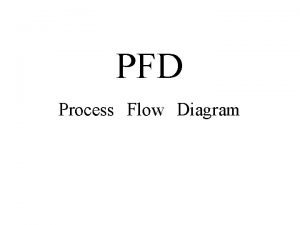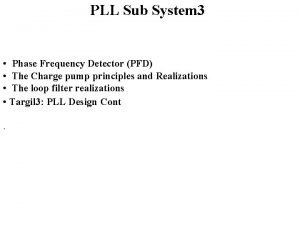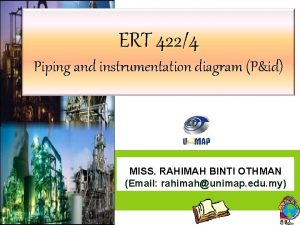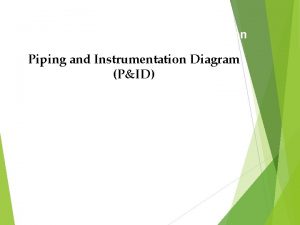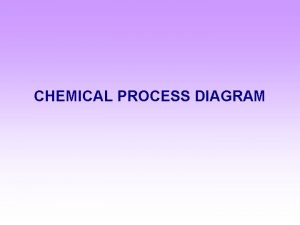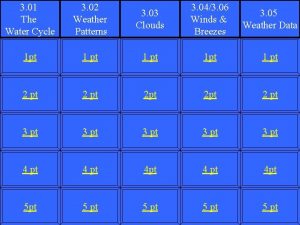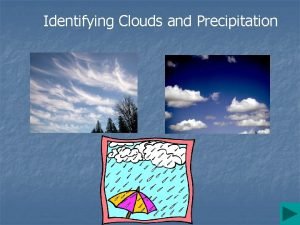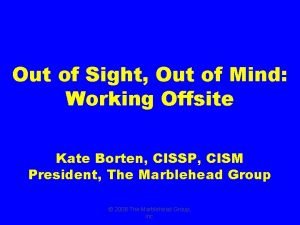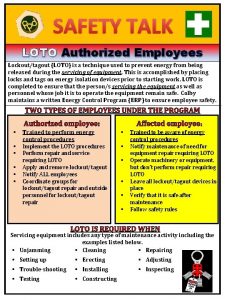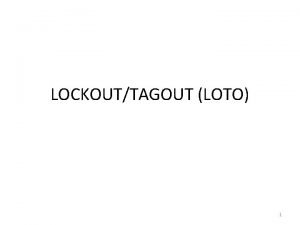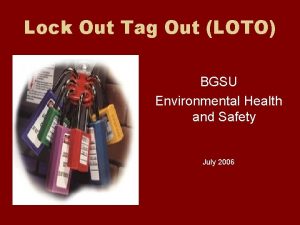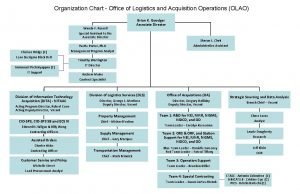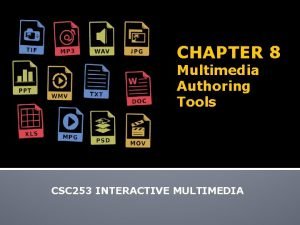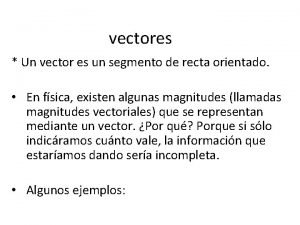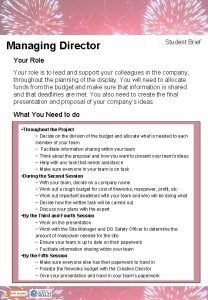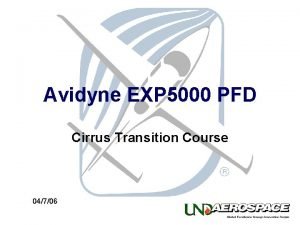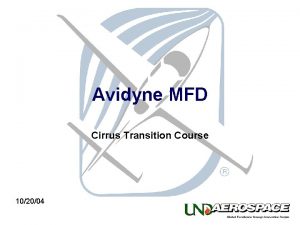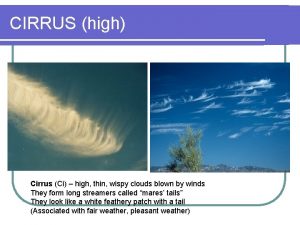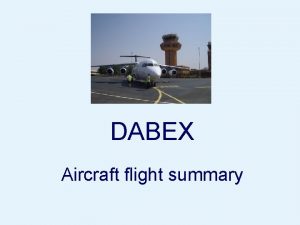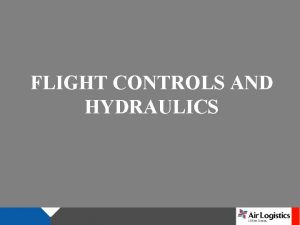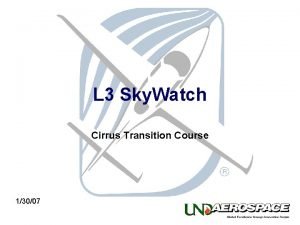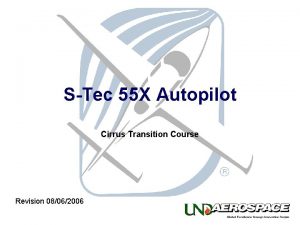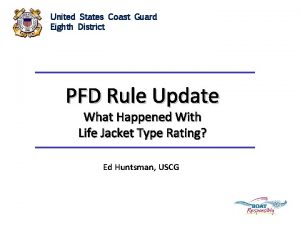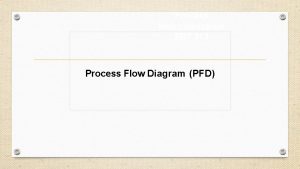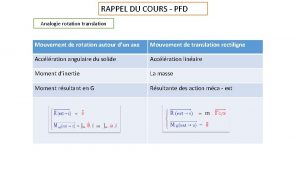Avidyne PFD With out Flight Director Cirrus Transition















































- Slides: 47

Avidyne PFD With out Flight Director Cirrus Transition Course 01/11/05

The system information, procedures and guidelines found in this presentation are for Reference Only. The information & procedures in this presentation have been taken from the FAA Approved Airplane Flight Manual and Pilot’s Operating Handbook (POH). The Information & Procedures in this presentation DO NOT SUPERSEDE the Information & Procedures in the POH. In the event of conflict, the POH shall take precedence.

* Table of Contents General System Structure Nomenclature Airspeed Turn Indicator and Inclinometer Aircraft Attitude Altitude Bug Navigation Source Selection Moving Map Flight Director PFD Initialization PFD Flying Procedures PFD Failures Limitations

General The Avidyne PFD incorporates the functionality of: Horizontal Situation Indicator (HSI) Vertical Speed Indicator VOR/LOC/GS Indicators Attitude Indicator Airspeed Indicator Turn Coordinator Altitude, Airspeed & VSI Bugs

General The flat panel liquid-crystal display is integrated with an Air Data / Attitude Heading Reference System (ADAHRS) Magnetometer (Magnetic Heading information) Three axis solid state gyro and accelerometer system AHRS Provides: Pitch Roll Yaw

Magnetometer Magnetic Heading OAT (1) * System Structure OAT Probe ADAHRS MFD OAT probe located on right side by engine cowling. Crossfill Skywatch (4) Stormscope GPSS Relay (2) Heading Bug Nav/GPS CDI Altitude Pre-Select VSI Bug AS Failure Flag Turn Coordinator (3) 2 Used only during a Complete PFD Failure for proper autopilot operations. Connected when PFD has no electrical power (CB’s pulled). Rate of Roll Altitude Transducer GS Blind Encoder GS = 35 kts Ground Speed Activation Switch 4 Skywatch has an Airspeed switch for automatic activation that is located in the pitot tube. Approximately set for 30 KIAS TAWS Processor TAWS Annunciator 1 The PFD’s OAT probe is located underneath right wing fuel vent panel. Used for TAS calculations, not Displayed on PFD if equipped with engine monitoring. 3 Turn Coordinator is an Inclined gyro placed behind the instrument panel.

PFD System Schematic

Nomenclature Airspeed Tape Scale: 20 to 300 knots + / - 20 knots of current airspeed visible Red Band (Low) 20 knots VS 0 White Band VSO VFE Green Band VS VNO Yellow Band VNO VNE Red Band (High) VNE or greater

* Nomenclature 1 Airspeed Trend Indicator Depicted as a Blue band Visible when airspeed changes at a rate greater than. 8 knots / second Indicates where the airspeed is predicted to be in 6 seconds.

Nomenclature 2 Altitude Trend Indicator • Depicted as a Blue band • Indicates where the altitude is predicted to be in 6 seconds • An arrowhead indicates a value beyond the current tape field of view.

* Nomenclature Turn Indicator and Inclinometer • The Blue rate of turn indicator displays the current rate of turn. • The indicator is marked for 1/2 and full standard rate of turn. • Typical bank angles for a standard rate of turn are approximately 27° in cruise conditions*. Note : When a blue arrowhead is present it indicates a value beyond 1 1/2 standard rate.

Nomenclature Inclinometer Represented as black trapezoid below angle of bank indicator The black trapezoid is centered under the roll pointer in coordinated flight. Full scale deflection is the width of the trapezoid.

Nomenclature Level flight may be obtained by placing the black dot in the middle of the aircraft reference symbol (“Flying-W”) on the horizon line in cruise conditions. The pitch angle for level flight will vary with flight conditions. Level flight for SR-20 is 145 KIAS (approx. 75% power) and the SR 22 is 160 KIAS at 6000’ MSL at gross weight.

Nomenclature Attitude Indicator Flying W – aircraft reference Bank Scale 0°, 10°, 20°, 30°, 45°, and 60° Pitch Scale Graduations every 2. 5° within ± 20° Graduation every 5° for pitch +30° / -20° 4 Excessive Pitch Chevrons Appear at +50° / -30° pitch angles ± 90° pitch attitudes small circles appear

* Nomenclature Altitude Tape +/- 220 feet from current altitude shown 20 foot graduations -1000 to 25, 000 foot scale Altitude Pre-select Digital display at top of altitude tape * Magenta bug displayed on altitude tape when within 200 feet of selected altitude Digital display adjacent to “Alt Bug” line select key

Nomenclature Altitude Bug Button (Alt Bug)- When selected, allows the right knob to control the position of the altitude bug and the autopilot altitude pre-select value. The range of values is the same as the altitude tape. The Alt Bug has three resolution setting modes: 1, 000 ft, 100 ft, and 10 ft. The default adjustment position is at the 1, 000 ft mode and each button press steps the adjustment position down one place. The selected numeric value appears in the button and in the Altitude Pre-select window on top of the altitude tape.

* Nomenclature Barometric Correction Setting Button (Baro Set)- When selected, allows the right knob to control the value of the barometric correction setting. The range of allowable values is 27. 50” to 31. 50”. The selected value appears in the button label and in the Barometric Correction Setting window. Pushing in the right hand knob will Sync the altimeter setting to 29. 92” * Note: Revision 5. 0 and higher, the altimeter setting will be remembered even after a shut down.

Nomenclature Vertical Speed Indicator Analog presentation between +2000 & -2000 fpm Digital presentation in excess of 2000 fpm Vertical Speed Preselect Magenta Bug displayed between +/- 1600 fpm Digital presentation adjacent to “VSI Bug” line select key Pushing in the right hand knob will Sync the VSI bug within 50 FPM of current vertical speed.

Nomenclature Navigation selection Active source selection cycled using “Nav” line select key Available sources: GPS 1 VLOC 1 GPS 2 VLOC 2 Displayed as Green needle on heading indicator Localizer and glideslope displayed adjacent to attitude indicator

Nomenclature Bearing selection Data source cycled using “Bearing” line select key Available sources: GPS 1 VLOC 1 GPS 2 VLOC 2 Displayed as Blue double-barbed needle on heading indicator Acts as a RMI, a course can not be set

Nomenclature Aux selection Data source cycled using “Aux” line select key Displayed digitally adjacent to “Aux” status indicator Includes Bearing to Distance & time to active waypoint show up only with a GPS waypoint No needle representation on HSI

* Nomenclature Range / View selection View is cycled by pressing “Range/View” line select key Available views: 360° w/ Moving Map 360° w/o Moving Map 120° w/o Moving Map

Nomenclature Range / View selection Range adjusts view of moving map Adjusted using Left knob Available ranges: 2 NM 5 NM 10 NM 20 NM 50 NM 100 NM 200 NM

Nomenclature Compass Rose Heading digitally represented at top of heading indicator Heading Bug Digitally displayed adjacent to “HDG Bug” line select key Magenta Bug displayed over compass rose Pushing in the right hand knob will Sync the heading bug to current heading.

* Nomenclature Wind Vector • Shows current wind in knots & direction • Can GPS 1 or 2 Derived depending on NAV source used Projected Ground Track • Shows your current ground track • Can GPS 1 or 2 Derived depending on NAV source used

Flight Director

PFD Initialization

* Initialization Software Revision 04 & Below Requires approximately 3 minutes to align Countdown begins when unit is 40 seconds from completing the initialization process Air data will become valid prior to attitude information Red X’s indicate invalid data Brightness Default: 75%

Initialization Software Revision 04 & Below Default configuration: HDG Bug: 360° Altitude Bug: Nearest hundred feet VSI Bug: 0 Baro Set: 29. 92 in. Hg Nav: GPS 1 Bearing: Off Aux: Off View: 360° w/ Moving Map

Initialization Software Revision 05 & above The Initialization screen displays immediately after power is turned on. The first initialization box is displayed for 30 seconds in normal alignments. It is imperative to remain stationary during that time. The third line, OK TO TAXI IN X SECONDS, indicates when it is permissible to taxi while the system is still aligning. Air data (airspeed, altitude, vertical speed) will become valid prior to attitude data. * NOTE: For faster alignments (3 minutes recommended Rev 05 PFD or less), it is recommended that the aircraft not be moved until alignment is complete. The OK TO TAXI screen is provided for increased flexibility during ground operations, but it may extend alignment time.

Initialization Software Revision 05 & above At the completion of that 30 second period, the following message is displayed. This display will be up for approximately 90 seconds during which movement is acceptable. Movement beyond that 90 second window will extend overall warm-up duration. * Note that the overall software version number is listed in the box as is the aircraft that the Vspeeds are set up for.

Initialization Software Revision 05 & above When the system is approaching its final alignment phase, the message changes to indicate that the pilot should bring the aircraft to a stop as soon as it is practical. * Final AHRS Alignment screen will change to show a 40 second count down timer Typical total alignment time is 3 minutes but may take longer if the aircraft is subjected to forward motion at this time. *Note: The Ready for Final AHRS Alignment screen will be presented for several seconds, even if and after the aircraft is stationary.

Initialization Software Revision 05 & above • In the event that the AHRS is unable to complete its alignment, the following display is presented. • If this occurs, wait approximately an extra 2 minutes in this state. • If the system picks back up on the alignment, a normal PFD will result. • If the display does not clear itself, contact a service center and provide the displayed error code.

Initialization all revisions Until a flight plan is activated in GPS/Nav 1, the HSI will show a red “X”in place of the CDI. Or a valid navigation signal is detected in VLOC mode.

PFD Failures

Failures Air Data Failure Shown by Red X’s Airspeed, Altimeter and VSI disappear Refer to standby instrumentation * Note OAT and TAS (3) will be replaced by dashes along with wind speed and direction (2).

Failures Heading Reference Failure 1 Heading Indicator 2 HSI * Note Heading Information will be removed along with the rate of turn indicator and heading bug. Moving map function will not work.

Failures Cross Check Attitude The pilot should scan standby instruments The warning message is automatically removed when the self-check monitor confirms the PFD attitude is valid.

Failures Recoverable Attitude Data Failure Occurs when: Attitude change exceeds 90° per second Small power fluctuation Gyros are reset by pressing “Fast Erect” line select key 10 Second Timer will start once button is pressed *Note you must Maintain Straight & Level Flight before and after pressing the “FAST ERECT” button.

Failures Non-recoverable Failure Cannot be corrected in flight USE Standby Instruments If in IMC proceed to nearest VFR conditions do not re-enter IMC

Failures Lamp or LCD failure Bezel Keys are lit, no display screen Check Brightness Controls Take system off line by use of CB’s, to ensure predictable autopilot operations.

PFD Limitations

Limitations 1. 2. 3. The PFD integrates with separately approved sensor installations. Adherence to limitations in appropriate installation POH supplements is mandatory. The Avidyne Flight. Max Entegra-Series PFD Pilot’s Guide, P/N 600 -00081 -000, Revision 03, or latest revision, must be available to the pilot during all flight operations. Flight under Instrument Flight Rules (IFR) is not permitted with the PFD or any standby indicator (attitude indicator or magnetic compass) inoperative. Refer to Kinds of Operation Equipment List. • Note • The Avidyne PFD software version is displayed on the PFD during system startup. 4. Serials 0002 and subsequent before installation of PFD software version 530 -00123 -XXX-REV 05 (where X can be any digit from 0 to 9) Backcourse approaches are prohibited.

Limitations 5. 6. 7. 8. 9. 10. 11. When the PFD is coupled with the Autopilot System, the following Limitations apply: Autopilot operation is prohibited above 185 KIAS. The autopilot must not be engaged for takeoff or landing. The autopilot must be disengaged for missed approach, go-around, and balked landing. Flaps must be set to 50% for autopilot operation in Altitude Hold at airspeeds below 95 KIAS. Flap deflection is limited to 50% during autopilot operations. The autopilot must be disconnected in moderate or severe turbulence. Minimum engage height for the autopilot is 400 ft AGL.

Limitations • WARNING • Autopilot may not be able to maintain all selectable vertical speeds. Selecting a vertical speed that exceeds the aircraft’s available performance may cause the aircraft to stall. 12. Minimum speed with the autopilot engaged is 1. 2 Vs for the given configuration. For VOR/GPS and ILS glideslope and localizer intercept, capture, and tracking, the following limitations apply: a. The autopilot must be disengaged no later than 100 feet below the Minimum Descent Altitude b. The autopilot must be disconnect during approach if course deviation exceeds 50%. The approach should only be continued by “hand-flying” the airplane. c. The autopilot must be disengaged at the Decision Height. d. 12 knot maximum crosswind component between the missed approach point and outer marker. e. The intercept of the localizer shall occur at least 5 miles outside of the outer marker.

Limitations f. If the crosswind component is greater than 12 knots and less than 17 knots, the intercept shall occur at least 10 miles outside of the outer marker. g. The intercept angle shall be no greater than a 45 -degree intercept. h. The ILS is flown at normal approach speeds, and within any STC or TC speed constraints and as defined in this flight manual. i. The flaps should be extended in the approach configuration prior to the Outer Marker. No further changes in the flap configuration should be made throughout the autopilot coupled approach. j. The glideslope is approached in such a manner to allow automatic arming of the glideslope, or if the glideslope is manually armed no more than 15% above the glideslope.

SRV and SR 20’s with S-Tec 55 SR Autopilots Bearing Pointer and AUX Navigation information will not be shown. VSI Bug will not be shown
 Fight flight freese
Fight flight freese One direction song one thing
One direction song one thing Heat exchanger pfd
Heat exchanger pfd Pfd pll
Pfd pll P&i visio
P&i visio Pfd
Pfd Fc in p&id
Fc in p&id 737 hud symbology
737 hud symbology Direct time
Direct time Pfd pid
Pfd pid I/p p&id
I/p p&id Pfd boiler
Pfd boiler Cirrus hyperreal
Cirrus hyperreal Describe a cloud
Describe a cloud Stratus cumulus cirrus
Stratus cumulus cirrus Cumulus stratus cirrus nimbus
Cumulus stratus cirrus nimbus Cirrus link solutions
Cirrus link solutions 02weather
02weather Cirrus na zatoki
Cirrus na zatoki Cumulus stratus cirrus and cumulonimbus clouds
Cumulus stratus cirrus and cumulonimbus clouds Cirrus แปลว่า
Cirrus แปลว่า Water drops
Water drops Wispy clouds that are found at middle elevations
Wispy clouds that are found at middle elevations Time
Time Find out the odd one out
Find out the odd one out Out out poem title meaning
Out out poem title meaning Msg tired
Msg tired Put out that light
Put out that light Makna out of sight out of mind
Makna out of sight out of mind Loto safety talk
Loto safety talk Loto
Loto Robert frost poems
Robert frost poems Bgsu quality systems
Bgsu quality systems Out, out by robert frost
Out, out by robert frost Out, damned spot! out, i say!
Out, damned spot! out, i say! Out of sight out of mind psychology
Out of sight out of mind psychology Owner job titles
Owner job titles Dr sethi bhopal
Dr sethi bhopal Logistics department organizational chart
Logistics department organizational chart Peter jackson auteur
Peter jackson auteur Pla director sociosanitari
Pla director sociosanitari Chapter 4 probability and counting rules
Chapter 4 probability and counting rules Advantages of icon based authoring tool
Advantages of icon based authoring tool Vector director
Vector director Orange county ems
Orange county ems English comic actor and film director
English comic actor and film director Regional de alajuela
Regional de alajuela Directors brief
Directors brief


